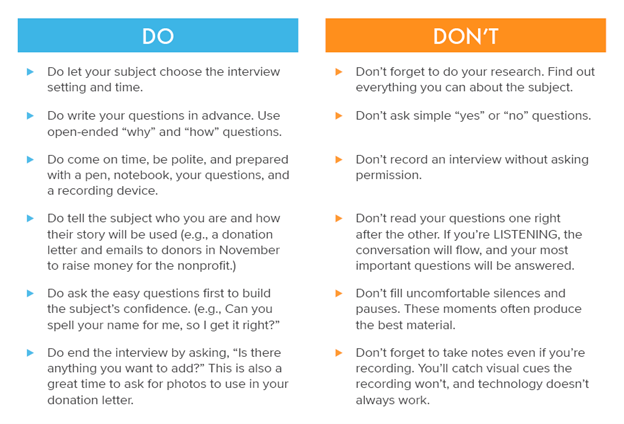Once upon a time, a fundraiser was super busy.
In fact, she was so busy that when it came time to put together her year-end donation letter she was stumped. What should she write?
Time was short, so she settled on writing a factual summary of her nonprofit’s achievements. Then she asked donors to help her reach her year-end financial goal.
Unfortunately, this appeal didn’t perform as well as it could have. Why? Because the letter didn’t include any inspiring year-end stories that touched donor’s hearts.
Why You Need Great Year-end Stories

Humans are hardwired to respond to stories. That’s why every culture uses storytelling to pass down vital traditions and values.
Neuroscientists would tell you that the brain processes facts and stories differently. Your brain naturally becomes more skeptical when you hear facts first.
But stories have the opposite effect. Your brain gets absorbed in the story and it drops its guard. That emotional bond with the story then allows any facts that follow to seem more real.
See this principle at work in these good and bad examples of nonprofit storytelling.
How to Spot Great Year-end Stories
Sometimes even the most skilled fundraisers find it hard to spot a story that’s going to spur donors to give. That task requires you to take off your thick organization glasses and see things from the donor’s fresh point of view.
The news values that professional journalists use to choose the best story ideas can help. Common news values are things like:
- Surprise: Ex: Woman finds wedding dress at a clothing bank;
- Novelty: Ex: Nonprofit staffer invents device that collects trash in streams;
- Triumph: Ex: Man overcomes addiction, goes on to manage treatment centers;
- Human interest: Ex: Teen learns adopted dog was used in dogfighting, so she uses her coding skills to help other shelter dogs in need;
- Proximity: Ex: Local student receives life-changing scholarship;
- Timeliness: Ex: Rare jaguar photographed near border wall construction.
The best stories contain multiple news values. Just remember that what your nonprofit thinks is interesting – such as an update on your newest program – may be better suited to a newsletter than your year-end donor appeal.
What Are the 7 Basic Story Elements?
 Once you have a winning story idea in hand, it’s now time to develop that story fully.
Once you have a winning story idea in hand, it’s now time to develop that story fully.
A lot of folks jump straight into writing at this point. But halfway through, they realize they don’t know enough about the story to write an effective donation letter.
Instead, make sure you have these 7 basic story elements on hand before you write:
- Start with one character. Multiple characters can confuse the donor and make it harder for you to write.
- Add essential details. Show the donor why this character is worth rooting for.
- Give them a goal. Dreams and desires move the plot forward and often reveal the inherent dignity of your character.
- Introduce the villain. This is the main challenge (Ex: poverty, disease, discrimination) the character must face.
- Describe the conflict. What steps did the character take? Were there setbacks? How did your donors help them?
- Show what changed. How is the character’s life different now?
- Don’t forget the narrative. Connect the story to the larger problem your donor will help solve with their gift. This is a great place to use your Core Number.
Download this infographic to make sure you collect and use the 7 basic story elements.
How to Collect the Story Elements You Need
If you’re a Founder or a leader of a small nonprofit, you probably have firsthand access to your story’s main character. That’s the best scenario, as you’ll see in a moment.
But fundraisers who work in medium-sized organizations may need to consult their program staff for story details. But this is the kind of reporting you’re likely to get back:
Denise, a mother with three minor children, requested assistance with rent and utility. The household suffered a loss of income when she and her husband’s work hours were reduced, and the household food expenses were increased due to school (reduced lunch program) closures due to COVID-19. Program X helped with $3,000 toward rent and $1,000 toward utility.
Not exactly heartwarming, right? And because there’s not much detail about Denise, it feels transactional, not emotional.
Your best chance of gathering the detail you need is to interview your main character in person. People communicate in words, with expressions, and with gestures. This is especially important if you’re talking with someone who has a disability or someone who’s speaking in a second language.
If you can’t meet in person — as we couldn’t amid the pandemic — choose the next best media. Typically, that’s a phone call.
Email is a distant third choice because people tend to respond more formally in writing. And like a Zoom conference, it assumes that your interviewee can easily access the Internet.
Finally, some folks will try to write appeals based on a video transcript. But that assumes the interviewer (not you) behaved in an ethical manner toward your story subject and that they gathered the right level of detail for your appeal. Not ideal.
If you’re new to interviewing, here are several reporter Dos and Don’ts that will help you conduct an ethical and successful interview:

Ready to Touch Donor’s Hearts?

Great storytelling can boost the results of your year-end donation letter.
But developing a complete story that moves donors to give takes time. To be safe, start brainstorming ideas for year-end stories ideas at least eight weeks before you want your letter to go to the U.S. postal service.
That’ll give you the time you need to find a story with strong news values. And do a first-hand interview so you gather all the basic story elements you need.
With that prep work done, I think you’ll find that the writing part is much easier. Your story will tell itself and your letter will delight more donors!
About the Author
Laura Ingalls is CEO of Abeja Solutions, a women-owned small business that helps nonprofits master direct mail. She works with executive directors and fundraisers to tell their stories in ways that create healthier, more stable funding for their missions. During her career, she’s produced for CNN International, served as a humanitarian spokesperson in Iraq, and led award-winning nonprofit and corporate communications teams. Learn more at abejasolutions.com.






Leave A Comment